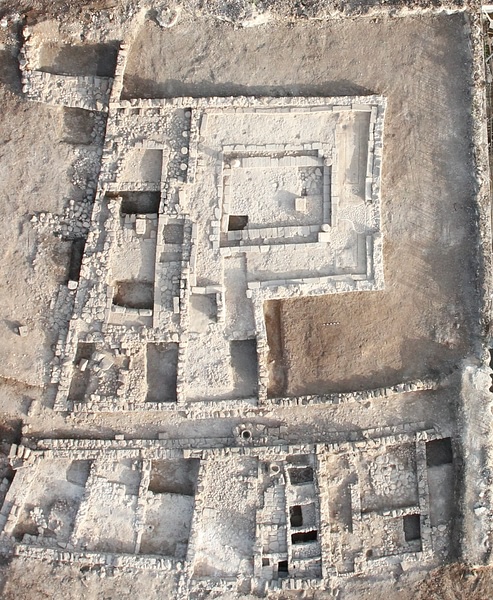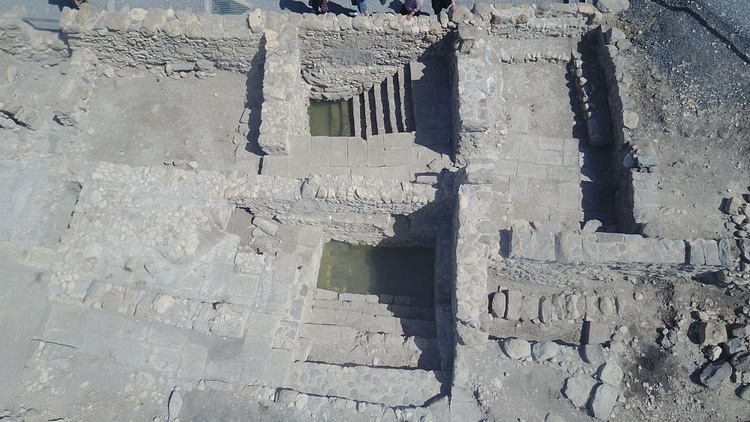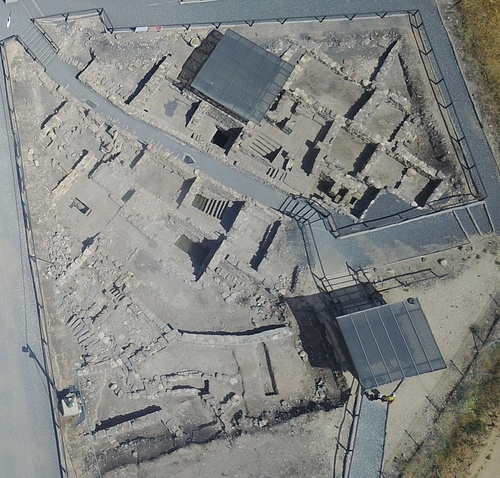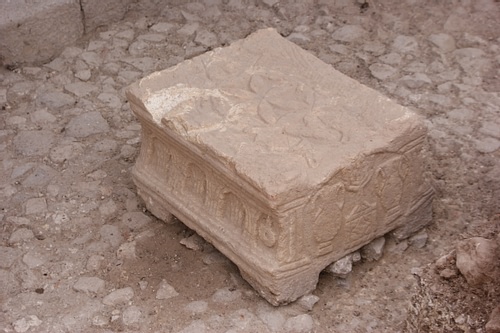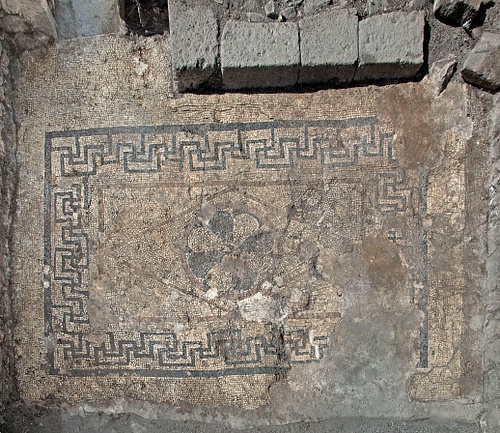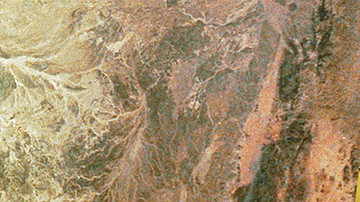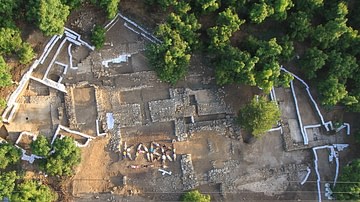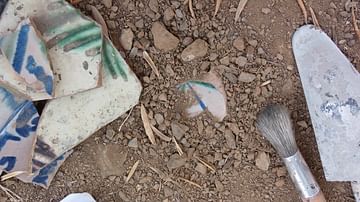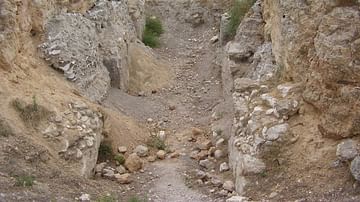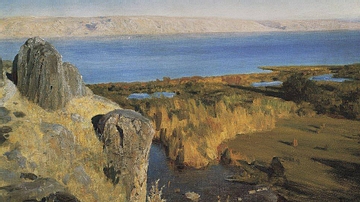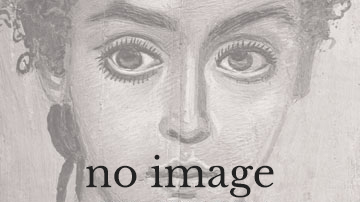Magdala, known as Migdal in Hebrew (מִגְדָּל: tower) and also as Taricheae (Ταριχέα, from the Greek Τάριχος or tarichos: preserved by salting or drying fish), was an important fishing town during the first century CE on the western shore of the Sea of Galilee and below Mount Arbel. According to biblical references, it was the hometown of Mary Magdalene and historical sources such as Flavio Josephus, Strabo, Pliny the Edler, Cicero, and Suetonius mention the importance of this town because of its excellent salted fish and important Roman markets.
GEOGRAPHICAL LOCATION
Magdala Taricheae is located in the Lower Galilee, a region in the north of Israel. Galilee is divided into Upper and Lower Galilee, Upper Galilee is to the north of Israel, currently on the border with Lebanon. It is a mountainous and forested area. During the first century CE, the settlements of Meron, Gush Halay, Nabratein, Gamla, Hazor, Zefat were developed.
The Lower Galilee “is a series of valleys and ridges ascending gradually from the western coastal plain into the interior, the dropping dramatically in elevation to the Jordan Valley and the lake (Sea of Galilee) in the east.” (Horsely, 20). This topographical division also allowed a political and economic division in the area. Some settlements developed during the first century CE in this region were Sepphoris, Nazareth, ("Tiberias"), Magdala, Capernaum, and Yodfat.
It is in this prosperous region (Lower Galilee) that Magdala developed during the first century CE. It is located 3 miles north of Tiberias which was founded by Herod Antipas between the years 17 and 20 CE to make it the capital of Galilee instead of Sepphoris, and 6 miles south of Capernaum, a fishing village traditionally known as the center of Jesus' public ministry, and where the house of Peter his apostle was located.
MAGDALA THROUGH HISTORY
According to historical sources and archaeological facts, Magdala was an important town with social and economic development. As a result of this progress, there was a "synagogue" with mosaic floors and walls decorated with stucco, dated to the first century; ritual baths (miqva'ot, in plural) with water flowing from an underground system; mosaic and basalt floor rooms, and courtyards.
Fishing and salting fish were the main activities of the town, industries which took place in the harbor and marketplace area. The marketplace next to the harbor had a beautiful stone slab floor with rooms along the sides, possibly used for commerce and production activities. This area was the heart of Magdala's trade.
During the Second Temple in the 1st CE, “Galilee plays a major role in various historical surveys of the Great Revolt against Rome in 66 – 70 CE.” (Rapport, 95). Flavius Josephus, a historical source from the first century wrote about the first revolt against Rome in his book The Jewish War where it mentions the Roman attack over Magdala Taricheae in year 67 CE. The Jewish rebels defended Magdala in the vicinity of Mount Arbel and defended the wall that surrounded the town, but they could not stop the entrance of Vespasian's legion, led by his son Titus, into Magdala. A massacre of the town's residence then followed. Josephus wrote about Magdala's destruction in this revolt, but until now the archaeological findings do not give information regarding how complete was the destruction.
The current archaeological findings such as ("coins"), pottery, and glass, indicate that the chronology of Magdala began in the Hellenistic period and continued until the middle Roman period. According to historical sources, during the 4th century CE Saint Helena, mother of "Emperor" Constantine the Great arrived at the ruins of ancient Magdala and built a basilica over what she believed was the house of Mary Magdalene according to what local people said during her quest of the holy places. She was one of the first pilgrims in the Holy Land who built churches and basilicas in places which tradition declared as holy.
Between the 4th and 6th century CE, different pilgrims wrote about these holy sites, such as Egeriae in her book: Itinerarium Egeriae; and Theodosius who made a list and description of the holy places known in those days, in his list Magdala is mentioned. However, we must bear in mind that in the case of Magdala, there is still no scientific evidence of its location as described in the accounts of these first pilgrims.
Early Archaeological Exploration
In the mid and late 19th century CE, British and North American explorations took place in the Holy Land with the objective of finding and registering all the relevant historical places that once were described by Flavius Josephus and pilgrims of later centuries.
* The Palestine Exploration Fund. - Distinguished academics and clerics who worked to promote and make historical, archaeological, topographic, cultural, geological and natural investigations of Biblical Palestine. This project was under the royal patronage of Queen Victoria.
* The American Colony. – This was an American Christian community formed in Jerusalem. Was commissioned to document through photographs and texts all the historical sites of the Holy Land, including Magdala.
The Franciscan Custody of the Holy Land has owned one part of the Magdala ancient town since 1912 CE. Between 1971 and 1977 CE archaeological excavations began, conducted by Father Stephano Loffreda and Father Virgilio Canio Corbo, when structures, streets and artefacts (1st BCE – 4th CE) were brought to the light. Through these excavations, it was possible to identify the foundation of Magdala Taricheae in the late Hellenistic period. It was the first time that Magdala was archaeologically assessed.
ARCHAEOLOGICAL DISCOVERIES IN MAGDALA
In the year 2002 CE, the Israel Antiquity Authorities (IAA) made some test pits at the south and north of the Franciscan area at Magdala; and the Franciscan Custody again took up archaeological activities in 2007 and 2008 CE led by F. Stefano de Luca. In 2009 CE the ancient synagogue of Magdala was discovered by the archaeologists Dina Avshalom-Gorni and Arfan Naijar from the Israel Antiquity Authorities, at the north of the Franciscan area.
The synagogue dates from the 1st century according to the archaeological findings such as coins and pottery fragments. So far, it is the only synagogue of this time that has a mosaic floor and walls decorated with colored frescoes: red, yellow, blue, black and white.
In the main room surrounded by stone-benches, found in one of the corners, there is a particular carved rectangular stone below a collapsed column. It looked as if this stone was placed there on purpose to hide it. This unique stone has relief decoration on its four sides and the top of it. On the front side is the relief of one of the earliest representations of a seven-branched menorah over a pedestal; on the two longer sides the reliefs of pillared archways; on the top surface is carved a large six-petal rosette flower flanked by two palm trees on the sides. The rosette is a symbol that is repeated in the mosaic of the synagogue and the ritual baths area. This unique stone “was apparently used as a base for reading table supporting the Torah scrolls.” (M. Zapata and R. Sanz, 41).
To the south of the synagogue a building was found which by its characteristics refers to a market and a production area. On one side of this building, facing the synagogue, water installations were discovered that were used to contained clean water, because according to the soil sample analysis there is no evidence of any chemical residue found inside the pools. On the west side of the building is a street with a basalt sidewalk and entrances to different market and production rooms which have coarse pottery ovens.
The Israel Antiquity Authority in 2010 and 2011 CE also excavated one part of Magdala's harbor which has a main street made of basalt and limestone stones, and the market area next to the lake. At an average distance of 260 m is the continuation of this harbor into the Franciscan area in which is evidence of the anchorage place where boats used to be anchored before and after their fishing and trade activities in the Galilee Sea.
From 2010 to 2011 CE archaeological excavations led by the archaeologist Marcela Zapata Meza from the Universidad Anáhuac México brought to light the discovery of the first ritual baths (miqva'ot) next to the Sea of Galilee fed by underground water. These miqva'ot are unique in all Israel because of the location and hydraulic and construction system. In antiquity, the lake waters were used for ritual purification, so it was believed that there was no sense of having a miqveh (ritual bath in singular); until now
The ritual area is composed (so far) of two buildings divided by a street. Each building has two stepped miqva'ot formed with basalt stones, and rooms with basalt floors for immersion preparation. One of these rooms has a polychrome mosaic floor (white, black, red) decorated with a rosette of eight petals (like the one in the synagogue) inside a rhombus.
At the east side of this area another building was discovered in which were found fishing tools such as lead weights and bronze hooks. According to the archaeological evidence, this building has a very basic construction system, most of its building stones have a rough finish compared to the ritual area construction.
52 meters to the east from this area is another building with a better constructive system. In this building grinding stones were found in situ, ovens made with coarse pottery, courtyards and stone paved rooms. The archaeological findings suggest that it was a domestic and production area.
INTERPRETATIONS of magdala
With the archaeological evidence found so far at Magdala it is clear the twon was a wealthy Jewish town in the Lower Galilee - no other town has this kind of miqva'ot, a synagogue with mosaic floors, or a complex hydraulic system with underwater flowing through the channels. Besides being known as an important place for salting fish and its relation to the Roman markets, now we know that the purity and ritual activities were an important factor in the daily life of Magdala inhabitants.
Around 2,500 coins have been found, mainly bronze from the 1st and 2nd century CE. So far the continuity of the coins' chronology, pottery analysis, and the architectural structures can all give us an idea that Magdala was not completely destroyed as Josephus wrote in his book thousands of years ago, it could well have endured major changes after the revolt but life continued in Magdala for many more years after.
